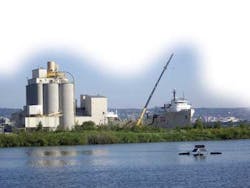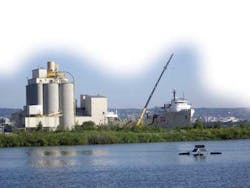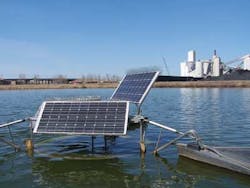Solar-Powered Mixers Help Wisconsin WWTP Conserve Energy, Costs
The Twin Ports of Duluth, Minn., and Superior, Wis., built on both sides of the St. Louis River where it enters Lake Superior, are together the largest port on the Great Lakes. Maintaining Lake Superior's water quality in such a busy and diverse ecological area is the responsibility of many agencies, not the least of which are local municipalities. For the city of Superior (pop. 27,000), meeting permit requirements for its wastewater treatment plant had become expensive due to the aeration runtime required for treatment. The city discovered a solution to the problem when it installed SolarBee mixers from Medora Corporation that reduced blower power while meeting requirements.
The city's wastewater treatment system consists of a 7.6 MGD activated sludge plant and three combined-sewer treatment plants (CSTPs). During snowmelt and heavy rains, the combined sewer flow, coupled with sanitary flow, could exceed the main plant's treatment and hydraulic capacity.
During such high flow events, combined sewage enters the CSTP facilities for storage/treatment. The CSTP #2 lagoon can hold combined sewage for processing through the main treatment facility after flows subside and/or treat combined sewage for direct discharge to Lake Superior Bay. CSTP #2 covers 13 acres and has an operating depth of 6 to 13 ft.; the maximum depth is 16 ft.
To provide adequate aeration, the city operated one 75-horsepower (hp) blower continuously and a second 75-hp blower during high-flow periods. The existing diffuser system maintained sufficient dissolved oxygen (DO) levels to allow the city to meet all permit requirements. However, blower electric power consumption had become very expensive.
"The sole objective for installing the SolarBee system was to reduce and possibly eliminate blower horsepower runtime and the associated electric costs," said Jon Shamla, operations manager, City of Superior.
The city installed four SolarBee SB10000v12 units in CSTP #2, and soon the city was able to turn off both 75-hp units during no-flow periods.
Typically only a small part of a wastewater treatment plant's aeration energy (20 to 50 percent) is actually used to produce dissolved oxygen (DO) for the BOD and nitrification bacteria. The rest of the energy is typically used just for the mixing effect to distribute the DO to the bacteria that need it.
SolarBee mixers accomplish the mixing effect by taking advantage of the way water forms thin horizontal layers in all reservoirs. The mixers pull water in from all corners of the basin, up to 700 ft. from the machine in all directions, at the desired depth based on the setting of the adjustable intake plate, as well as provide vigorous effective mixing. Mixing distributes the DO evenly throughout the mixed depth using very little energy. As a result, operators can turn down their aeration to just produce the required DO.
"Currently, we run one of these [mechanical blower] units only when flow enters the basin, which occurs on an average of 74 days per year," said Shamla.
At a power rate of $0.04/kW during the time of installation, the city saved over $8,000 per month. The blowers now run 20 percent of the time instead of 100 percent of the time (74 days instead of 365 days per year).
In addition, surface re-aeration through SolarBee-induced circulation has maintained sufficient DO levels so anaerobic sludge digestion gases are oxidized as they pass through the aerobic water column, thus preventing odors. Without thorough mixing, the organic solids entering the pond will tend to settle to the bottom and, over time, the anaerobic digestive process at the bottom can create ongoing odor problems. But by keeping the solids and water thoroughly mixed, the solids move on to the plant instead of settling to the bottom, and the detention time of both the water and the solids is too short for the anaerobic process to ever pick up any momentum and create an odor problem.
"They [SolarBee mixers] seem to do a fine job keeping algae at bay," said Shamla. "The main source for our happiness is that we don't have to run 75-hp blowers when we are not taking water into the basin."
By keeping algae at bay - and out of Superior Bay - the city of Superior is helping to maintain high standards for clean water in a diverse ecological region while also saving important energy dollars.
Medora Corporation is an exhibitor at the WEFTEC.13 event and can be found at Booth No. 4041.


